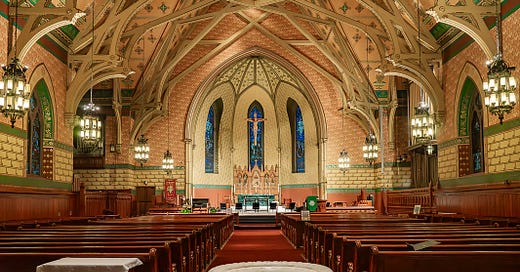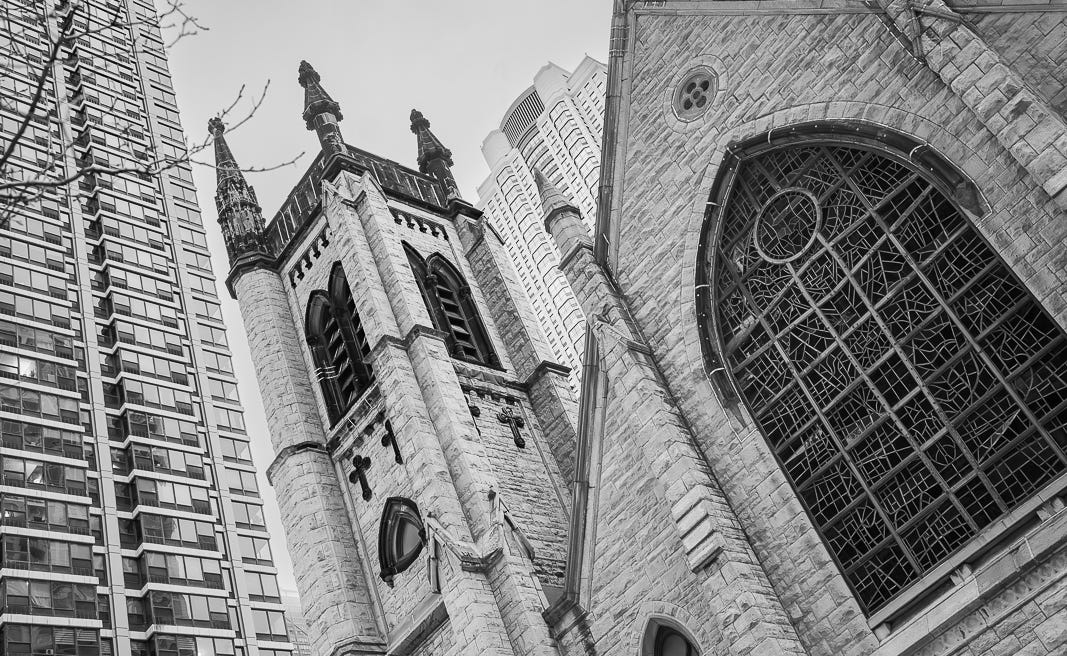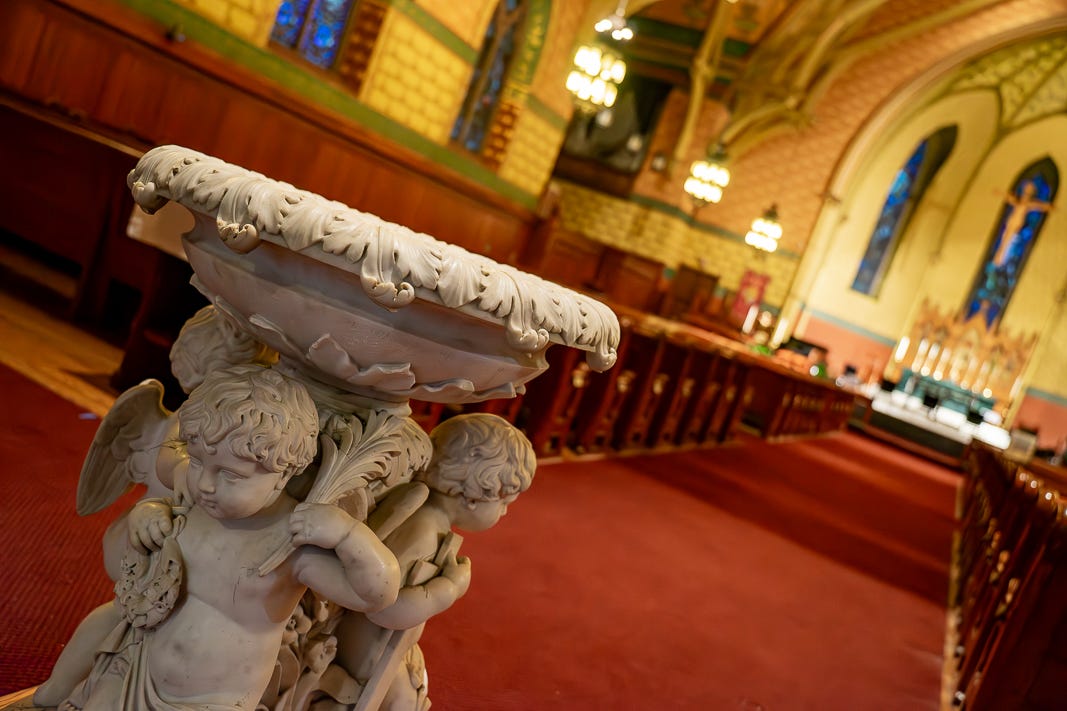Church Number 3: St. James Cathedral
I had a difficult week.
A couple members of my ex-husband’s family thought I should be excluded from a big family event. I won’t go into all the details, but suffice it to say that this was shocking because I have been a very close part of the family for the twenty plus years since my divorce. Luckily, the rest of the family assured me in no uncertain terms that everyone else wanted me there.
In the meantime, it stirred up a lot of tough feelings. And I definitely had a physical reaction. I was sick to my stomach and couldn’t sleep. It brought up old, primitive, and triggering feelings: being unacknowledged, not considered, unworthy.
So it’s been tough. And then as I woke up Sunday and reflected on the previous week’s service at Fourth Presbyterian, I remembered the message from the sermon. “This is my beloved Son, with whom I am well pleased.” And that actually brought me comfort. It was true. Even when we feel unworthy, we are beloved. I probably should have done the homework the pastor had given us to reflect on that passage everyday during the week to give us strength.
So I was looking forward to going to church today, hoping that maybe I would find some solace in the turmoil and heartbreak and loneliness going on in my head and my body.
The congregation of St. James began in 1834, making it the oldest church of the Anglican Communion in Chicago. But what is the Anglican Communion? We have to go back to England to find the answer.
The Anglican church, also known as the Church of England, was formed, as you may recall, back in the early 1500s when Henry VIII decided to divorce his wife Catherine of Aragon against Catholic doctrine so that he could marry Anne Bolyn. The only way to make that happen was to leave the Catholic church and replace it with a new church for England.
It should come as no surprise that as more and more English moved to the New World that they brought their religion with them. After the Revolution, Anglicans in the United States became known as Episcopalians.
For most of the church’s history, the relationship between the churches in the Anglican Communion, led by the Bishop of Canterbery, has been friendly, But in more recent years, with some churches taking more liberal stances on a variety of topics, in particular the approval of women and gay bishops and then supporting gay marriage, causing a rift in the church.
It started in 1989 when the Anglican Communion approved the ordination of women as priests and bishops. Then in 2003, Gene Robinson was ordained in New Hampshire as the first openly gay bishop. In 2005, Right Reverend Katharine Jefferts Schori became presiding bishop, making her the first female head of the nationwide Episcopal Church. In 2009, some of the more conservative churches separated from the Episcopals and formed the Anglican Church of North America.
The next important decision took place in 2012 when the Episcopal Church in the United States approved a same-sex blessing service called “The Witnessing and Blessing of a Lifelong Covenant,” making it the largest denomination to approve same-sex relationships.
All of this led to the Anglican Communion in 2016 to suspend the Episcopla Church in America from voting and participating in decisions for three years.
It appears that the latest in this story is that in February 2023, the Archbishop's Council of Church of England allowed a blessing ceremony for same-sex couples.
I was trying to figure out where St. James fell in terms of being from the more conservative or more liberal faction. Their website indicates that the church is part of the Anglican Communion. However, the church also has a page on its website titled “Social Justice,” where it explicitly states its support of Black Lives Matter and the LGBTQ+ community. The church also participates in the annual Chicago Pride Parade.
With that background, it’s interesting to learn that a woman was actually largely responsible for bringing St. James to Chicago: Juliette Kinzie. Anyone living in Chicago will recognize the name as the name of the street that runs east and west one block north of the Chicago River.
When Juliette Kinzie first visited Chicago in 1831, the city only had 200 inhabitants. She and her husband John moved from Fort Winnebago in what is now Wisconsin and where he was an Indian agent to the Ho-Chunk nation to Chicago in 1834. Juliette later wrote a book about her experiences at the fort and her early years in Chicago: Wau-Bun: The ‘Early Day’ in the Northwest. Also of note, John Kinzie’s father is famous as the first murderer in Chicago. It occurred in 1812, the day before the War of 1812 was declared and when John was nine years old. The elder Kinzie stabbed Jean Lalime, an interpreter at Fort Dearborn, after the two argued. The cause of the argument has been lost to history.
Both John and his wife Juliette were considered key city founders. For example, John served on the Chicago Board of Trustees and was the first sheriff. But what is important here is that Juliette had been active in the Episcopal church, and she is credited with helping to organize the first Episcopal service in Chicago in October of 1834, thus founding the St. James Church.
Just a side note that made me sad. She ended up dying thanks to pharmaceuticals. When she was in New York visiting one of her seven children, a druggist gave her morphine instead of the quinine that she requested. Ugh.
Now for the building!
The building for the congregation was completed in 1857. And in 1860, none other than Abraham Lincoln stopped by the church to pray shortly after he was elected president.
Then, as is the common story of early Chicago, the church burned down in the Chicago Fire of 1871. All that remained was the bell tower and some of the stone walls. When it was rebuilt, they kept the bell tower, and the soot on the stones is still visible today. (Although some argue that the black is actually from later pollution.) In addition, a Civil War Memorial dedicated to ten members of the congregation who died in the Civil War also survived the fire and is still displayed in the church today.
Nearly a century later, in 1955, the church was designated as the Cathedral for the Episcopal Diocese of Chicago.
Finally, in 1966, St. James was host to Martin Luther King, Jr., Mayor Richard J. Daley, and other leaders to discuss civil rights.
But let’s get to the service!
No surprise, the church is gorgeous. All of these big, old churches are, to be honest. To walk into these huge, open spaces is awe-inspiring. I really loved the stenciled walls. Also, the organ was playing when I walked in; it felt majestic. It was pretty empty, and the people who were there were spread way out. And it was very male heavy; plus most of the men were alone.
Before the service started, I glanced through the program. This one included literally every word from the service. Every word for each of the readings, the words of the pastor, the full hymns with music, and the lyrics of all the songs the choir sang (if the song was in Latin, it had the Latin lyrics as well as the English translation). I’m not sure I like that. It ends up that our heads are bowed down in the program, reading rather than listening and taking it all in. Maybe? I don’t know. I know this makes it better for all types of learners, so to speak. But it seems weird. Shouldn’t we be fine tuning our listening skills? Plus, isn’t this a huge waste of paper, for crying out loud? Are we not worried about that anymore??
Ok, enough of that.
The service was similar to a Catholic service, which shouldn’t be surprising. One similarity was petitions, a request for a prayer. Often the petitions are pretty broad: for people in war zones, for the sick, for those struggling in poverty, etc. This church chose petitions pulled straight from the headlines all over the world. There were prayers for Ukraine, for an airplane crash, for those who have suffered due to natural disasters. To Joe (Biden) and to JB (Governor Pritzker). That was odd. They are on a first-name basis?
Next was for those in Chicago with “food insecurity.” I couldn’t help but notice the language. What is the purpose of such euphemisms? It’s a term that feels like it was dreamed up in some disconnected academic’s office.
Petitions were given for victims of shootings in Chicago, and specifically named three such victims:
Kadmiel B. Barney: 47 years old, shot in the chest and killed at 4 AM in Englewood, gunshot wound to the chest. I’m not sure the conditions of the shooting,, but it turns out, he was a sex offender on the registry list. Without going into too much detail, Kadmiel was convicted of predatory criminal sexual assault. He was 26 at the time, and the victim was seven. He got 12 years for that offense.
Kavatish Wallace: 23 years old, found on ground in West Englewood with shots to abdomen and shoulder. He was previously arrested when he was 18 years old he committed an armed robbery in the River North neighborhood.
Chamaine Davis: 28 years old, shot in the neck in Englewood. Prior to this, he stole a car and took the police on a car chase.
Seems an interesting choice of people to name.
A few other observations.
The offering was very casual. Plates were not passed down the pews. Instead, the ushers simply walked slowly down the aisles and waited for people to signal to them to stop. Of course, all of these churches have the means to give money digitally, oftentimes through a QR code in the program.
For communion, the pastor let everyone know that they would be offering wine for anyone comfortable with taking it from a chalice. She also announced that they have non-alcoholic wine as well as gluten-free wafers. Then people filed up to the front and kneeled along the rail at the altar to await to be served. I had forgotten that this is exactly how we did it at my church growing up. Except we had individual little cups of wine rather than drinking from a chalice. And of course, there was no gluten-free wafers offered!
One thing I loved was that there was only one elderly black woman in the congregation (despite a black deacon, a black usher, and a black altar server). She was dressed nicer than anyone else in the building, and had a sweet hat to compliment her outfit. But she struggled to walk. So the pastor held her hand up and then took communion to her in her pew.
Time for the sermon.
The pastor was another woman, like last week. In fact, she looked very similar: short blond hair, middle aged. She also read her sermon. But her style was quite different. She seemed like she was a professionally trained speaker, who now just came across as robotic and manufactured. As a result, she felt very disconnected from the congregation.
The Gospel reading was from John 1:29-42 (what follows is not necessarily the same version that was read in the church!).
29 The next day he saw Jesus coming toward him, and said, “Behold, the Lamb of God, who takes away the sin of the world! 30 This is he of whom I said, ‘After me comes a man who ranks before me, because he was before me.’ 31 I myself did not know him, but for this purpose I came baptizing with water, that he might be revealed to Israel.” 32 And John bore witness: “I saw the Spirit descend from heaven like a dove, and it remained on him. 33 I myself did not know him, but he who sent me to baptize with water said to me, ‘He on whom you see the Spirit descend and remain, this is he who baptizes with the Holy Spirit.’ 34 And I have seen and have borne witness that this is the Son of God.”
35 The next day again John was standing with two of his disciples, 36 and he looked at Jesus as he walked by and said, “Behold, the Lamb of God!” 37 The two disciples heard him say this, and they followed Jesus. 38 Jesus turned and saw them following and said to them, “What are you seeking?”And they said to him, “Rabbi, where are you staying?” 39 He said to them, “Come and you will see.” So they came and saw where he was staying, and they stayed with him that day, for it was about the tenth hour. 40 One of the two who heard John speak and followed Jesus was Andrew, Simon Peter's brother. 41 He first found his own brother Simon and said to him, “We have found the Messiah.” 42 He brought him to Jesus. Jesus looked at him and said, “You are Simon the son of John. You shall be called Cephas” (which means Peter).
The pastor, as they so often do, does her best to relate to her “audience,” and talks about how often all of us post on social media. But then she scolded us by pointing out “Look, I see God.”
But it should be important to note that Jesus did not call for followers. Instead, John pointed to his followers to follow Jesus. Jesus asked the people what they were looking for. And most of them felt insecure, vulnerable, or nervous.
The pastor then told the congregation that being asked a question such as this as individuals is much more difficult than being asked as a community. It would be less difficult to answer such a question as a community.
I feel like this isn’t making much sense. But that is exactly how I felt in the service. The sermon was clearly well thought out since it was written down, but it also seemed very loose.
I would also say that I am not sure I liked this comment about how much easier it is to answer hard questions when in a mob, er, I mean a group or community. A lot of bad answers are given when people are anonymous as members of a group. It seems to me that the church would encourage people to have the strength of their convictions, of their principles, of their faith to be able to speak up as an individual rather than having to wait for the group to find the strength to do so. But I digress….
The job of the church, the pastor continued, is to communicate with God as a community.
And that point I definitely understand.
In fact, Martin Luther King, Jr. had been to this very church before. The pastor read from the last speech MLK gave on April 3, 1968, titled “I’ve Been to the Mountaintop,” delivered the day before he was killed in Memphis. In it, he relays a vision he had: “if I were standing at the beginning of time, with the possibility of general and panoramic view of the whole human history up to now, and the Almighty said to me, "Martin Luther King, which age would you like to live in?” he would choose exactly the times in which he was living.
MLK expanded on that.
“Now that's a strange statement to make, because the world is all messed up. The nation is sick. Trouble is in the land. Confusion all around. That's a strange statement. But I know, somehow, that only when it is dark enough, can you see the stars. And I see God working in this period of the twentieth century in a way that men, in some strange way, are responding--something is happening in our world. The masses of people are rising up.”
As the pastor pointed out, he said, “Look, I see God.” And then he was killed within 24 hours.
In the Bible, John also suffered after he said he saw Jesus. He was imprisoned. But it is always difficult for prophets. And even so, this is the task for all of us.
The conclusion of her sermon told us that as a church, all of us need to be saying, “Look, we see God,” and we need to point this out to others so that they will follow him also. It was a clear call to evangelize. Which is fine, but not all that inspiring…to me.
When the service ended and the choir walked down the aisle to the back, everyone in the congregation turned to face them. And the place remained silent and still until the organ finished the closing song.
I wish I could say that I left the service feeling inspired or even introspective. But definitely, the music was gorgeous.
Next week? LaSalle Street Church
If you enjoyed this post, you can support my writing by leaving a tip or a custom donation. Just click on the button below. Thanks for your support!








